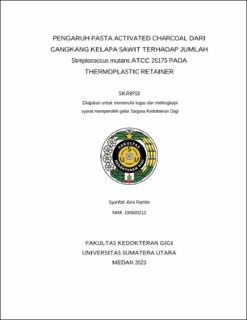| dc.contributor.advisor | Nugroho, Teguh Aryo | |
| dc.contributor.author | Rambe, Syarifah Aini | |
| dc.date.accessioned | 2024-02-07T07:13:44Z | |
| dc.date.available | 2024-02-07T07:13:44Z | |
| dc.date.issued | 2023 | |
| dc.identifier.uri | https://repositori.usu.ac.id/handle/123456789/91045 | |
| dc.description.abstract | The use of thermoplastic retainers can induce changes in the oral environment and can increase the number of Streptococcus mutans bacteria. A natural material from waste that can be used as a retainer cleaner is palm oil shells which are turned into activated charcoal which is believed to be antibacterial. The purpose of this research was to determine the difference in the mean number of Streptococcus mutans bacterial colonies on thermoplastic retainers after being immersed in artificial saliva contaminated with Streptococcus mutans, brushed with 0.12% chlorhexidine paste and brushed with 10% activated charcoal paste from palm oil shells. This research is a laboratory experimental with a post-test only control group design. Using 27 thermoplastic retainer samples measuring 2x2 cm in square shape which were divided into 3 treatment groups. Calculation of the number of bacterial colonies using the TPC method and using a colony counter. The results of the research show that the average number of Streptococcus mutans bacterial colonies in the thermoplastic retainer group without treatment was 592.2 ± 48.3 CFU. The mean number of colonies in the group that was brushed with 0.12% chlorhexidine paste was 38.2 ± 11.9 CFU. The average number of colonies in the group that was brushed with 10% activated charcoal paste was 157.6 ± 26.5 CFU. The results of the One Way Anova test showed that there were significant differences and the results of the Post Hoc LSD test showed that there were significant differences in the mean number of bacterial colonies between the treatment groups. The conclusion from this research is that there is influence of 10% activated charcoal paste from palm oilsShells in reducing the number of Streptococcus mutans bacteria on thermoplastic retainers, although it has higher average than 0.12% chlorhexidine paste on the number of Streptococcus mutans. | en_US |
| dc.language.iso | id | en_US |
| dc.publisher | Universitas Sumatera Utara | en_US |
| dc.subject | Thermoplastic retainer | en_US |
| dc.subject | Activated charcoal | en_US |
| dc.subject | Streptococcus mutans | en_US |
| dc.subject | SDGs | en_US |
| dc.title | Pengaruh Pasta Activated Charcoal dari Cangkang Kelapa Sawit terhadap Jumlah Streptococcus mutans ATCC 25175 pada Thermoplastic Retainer | en_US |
| dc.type | Thesis | en_US |
| dc.identifier.nim | NIM190600212 | |
| dc.identifier.nidn | NIDN0018108601 | |
| dc.identifier.kodeprodi | KODEPRODI12201#Pendidikan Dokter Gigi | |
| dc.description.pages | 87 Halaman | en_US |
| dc.description.type | Skripsi Sarjana | en_US |


